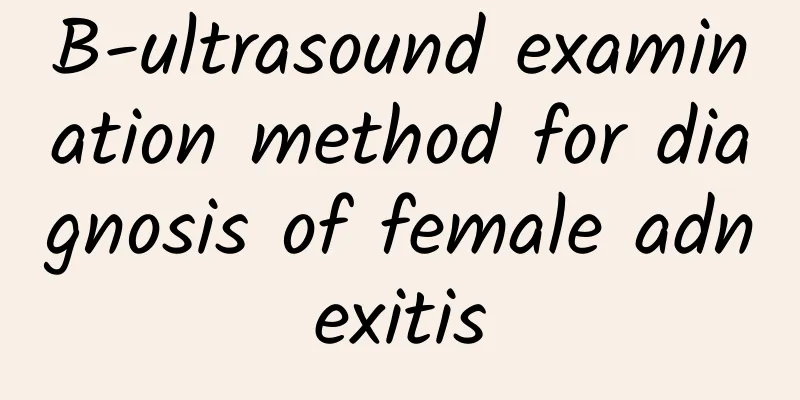B-ultrasound examination method for diagnosis of female adnexitis

|
It is usually difficult to check whether patients with adnexitis have adnexitis, but B-ultrasound examination of adnexitis can quickly detect whether there is a mass in the adnexal area, and it is not very expensive. However, if there is no mass, adnexitis cannot be ruled out, and blood and urine tests must be combined to see if there is an inflammatory reaction. B-ultrasound must be done. The best way to check for adnexitis is to have a gynecological examination. B-ultrasound examination of adnexitis Gynecologists say abdominal pain is often manifested as severe pain on both sides of the lower abdomen, which is resistant to pressure, and sometimes one side of the lower abdomen is more painful than the other. In addition, patients may also have symptoms such as increased leucorrhea, increased menstrual volume or prolonged menstrual period, or irregular vaginal bleeding. A small number of patients have abdominal distension and adnexitis. Ultrasound examinations can show intestinal symptoms such as diarrhea, or bladder irritation symptoms such as frequent urination and urgency. Gynecological examinations can show: purulent secretions flowing out of the cervical opening, and cervical pain when raised. Pelvic tissues feel edematous and tenderness is obvious. Laboratory tests: White blood cells and neutrophils are increased. Lower abdominal pain and perineal pain after sitting for a long time are considered to be vaginitis, pelvic inflammatory disease, adnexitis, etc., but the causes of lower abdominal pain and perineal discomfort can also be caused by urinary system diseases and other diseases. It is recommended to receive symptomatic treatment under the guidance of the attending physician, based on the results of B-ultrasound examination of adnexitis and comprehensive analysis of clinical symptoms. The two most common symptoms of this disease are abdominal pain and fever. Adnexitis can be diagnosed based on secretions If the doctor's observation, examination and palpation show that the leucorrhea is purulent or homogeneous mucous, and the adnexa are tender and painful, then adnexitis can be diagnosed. Adnexitis should be diagnosed based on clinical symptoms. If it is chronic adnexitis, during the examination, the lower abdomen can be palpated and there will be tenderness. Pelvic examination will show thickening and tenderness on both sides of the uterus. Sometimes an enlarged, fixed cystic mass can be felt. If these symptoms are present, it can be diagnosed as adnexitis. The above is an introduction to B-ultrasound examination of adnexitis. I hope that the introduction of B-ultrasound examination of adnexitis can bring you some help. If you want to know more, please consult our gynecological experts. Experts remind female friends that if they suffer from adnexitis, they should go to the hospital for treatment in time, because adnexitis can cause female infertility and endocrine disorders. |
<<: Methods for diagnosing and treating third degree cervical erosion
>>: How to prevent recurrence of cervical erosion
Recommend
Predisposing factors for acute pelvic inflammatory disease
Acute pelvic inflammatory disease is more common ...
Does adenomyosis affect the uterus and rectum?
Adenomyosis is one of our common diseases, and it...
What Chinese medicine can I take for endometrial thickening
I started to have dysmenorrhea after getting marr...
Clinical features of senile vaginitis
Senile vaginitis is caused by ovarian function de...
What are the treatments for right ovarian cysts and what should we pay attention to in our daily life?
What are the treatments for right ovarian cysts? ...
How long does it take for women to take medication for chronic cervicitis? Two or three courses of symptomatic medication are best
How long it takes for chronic cervicitis to be cu...
Ovarian cyst examination for everyone to introduce
As the incidence of ovarian cysts increases, peop...
What is the etiology and pathogenesis of bacterial vaginosis?
Vaginitis is a common gynecological disease, and ...
How to prevent recurrence of cervical erosion
How to prevent the recurrence of cervical erosion...
Be extremely cautious when it comes to painless abortion
When we turn on the TV, we often see advertisemen...
What are the items to be checked after abortion? Two things to pay attention to after abortion
In case of unexpected pregnancy, everyone will ch...
How to prevent miscarriage in patients with adenomyosis?
A woman's uterus is not only vital to her own...
Does bacterial vaginosis affect menstruation?
Will bacterial vaginosis cause irregular menstrua...
What are the common symptoms of uterine fibroids? Is frequent urination and difficulty urinating a manifestation of uterine fibroids?
Gynecological uterine fibroids are mostly multipl...
Control your weight well and stay healthy without worries. 4 dietary tips to help you lose fat easily
Food is the most important thing for people, and ...









